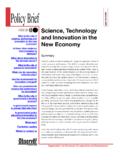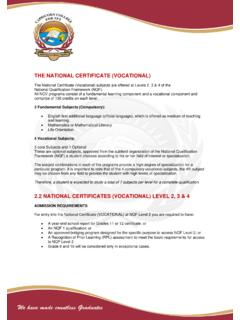Transcription of Science, technology and innovation for sustainable ...
1 Science, technology and innovation for sustainable development in the global partnership for development beyond 2015 Thematic Think Piece ITU,OHCHR, UNCTAD, UNEP, UNESCO, UNFCCC, UNIDO, WIPO, WMO The views expressed in this paper are those of the signing agencies and do not necessarily reflect the views of the United Nations. January 2013 2 Following on the outcome of the 2010 High-level Plenary Meeting of the General Assembly on the Millennium Development Goals, the United Nations Secretary-General established the UN System Task Team in September 2011 to support UN system-wide preparations for the post-2015 UN development agenda, in consultation with all stakeholders.
2 The Task Team is led by the Department of Economic and Social Affairs and the United Nations Development Programme and brings together senior experts from over 60 UN entities and international organizations to provide system-wide support to the post-2015 consultation process, including analytical input, expertise and outreach. 3 Science, technology and innovation for sustainable development in the global partnership for development beyond 2015 A post-2015 agenda for development: Ensuring equitable and inclusive globalization Debates on how best to promote sustainable and inclusive development are incomplete without a full consideration of issues of science, technology and innovation (STI).
3 Access to new and appropriate technologies promote steady improvements in living conditions, which can be lifesaving for the most vulnerable populations, and drive productivity gains which ensure rising incomes. There are two essential STI issues that need to be tackled simultaneously in the post-2015 development agenda. Firstly, innovation driven growth is no longer the prerogative of high income countries alone, some developing countries have achieved significant economic growth through the creation and deployment of STI capacity.
4 But, this has not been the case for all countries, in particular LDCs. Secondly, STI policy has often been pursued independently of the broader developmental agenda; it is important that STI be integrated into public policy goals, giving particular focus to the nexus between STI, culture, education and development. In addressing these issues, STI will need to be made more participatory and inclusive so that there is public engagement in the scientific endeavor from the full spectrum of social actors, including women, young people and indigenous communities.
5 The least developed countries will require dedicated support to bolster their efforts to build STI capacity. 4 Technological learning and innovation capacity: a cross-cutting issue for inclusive development The technological challenge and global public goods1 In the MDGs, issues of science and technology have focused predominantly on access to essential medicines (particularly for the treatment of HIV/AIDS) and on internet connectivity and the related spread of communication technologies (ICTs).
6 The favoured approach has been through needs assessment and targeted capacity building. However, delivering on the full range of amenities which underpin the MDG agenda, including, inter alia, environmental protection, the containment of health epidemics, mitigating climate change, requires access to a range of appropriate technologies. Much of the required technology is already available in the public domain but accessing and linking them to the required knowledge and skills within countries is neither automatic nor costless.
7 It calls for investments in dynamic capabilities, particularly those that shape the ability of national stakeholders to uptake and absorb technologies and make improvements in line with local circumstances. This is not a one-way process. Some level of technological capabilities in countries is critical to ensure the provision of these amenities to all. At the same time, the critical importance of such amenities spans beyond individual countries or regions.
8 In such a case, the international community as such, has a collective responsibility to ensure the provision of these goods (Stiglitz, 2007, among others).2 Within the UN Framework Convention on Climate Change, the new technology Mechanism established by the Cancun Agreements in December 2010 represents a move towards a 1 Public goods are those goods that exhibit non-rivalrous consumption (the use by one individual does not diminish the availability of the resource to another)
9 And non-excludability (when it is difficult to exclude people from consuming the good). The notion of global public goods is a recent concept that builds on established economic literature on public goods; public goods are referred to as global public goods when they have benefits that are universal in nature spanning across countries and people. While the boundaries of the term global public goods is still being debated, the fundamental idea is that for those goods that can be called as such, the international community has a collective responsibility to ensure the provision of those goods (See for example, Stiglitz, 2007).
10 2 Stiglitz, ,' Knowledge as a Global Public Good' in International Intellectual Property in an Integrated World Economy, F. Abbot, T. Cottier, and F. Gurry, eds., Aspen Publishers, 2007. 5 more 'dynamic' arrangement by fostering public-private partnerships; promoting innovation ; catalyzing the use of technology road maps or action plans; mobilizing national, regional and international technology centres and network; and facilitating joint R&D activities. Scaling-up and extending this kind of approach will be a central part of the post-2015 global partnership.















